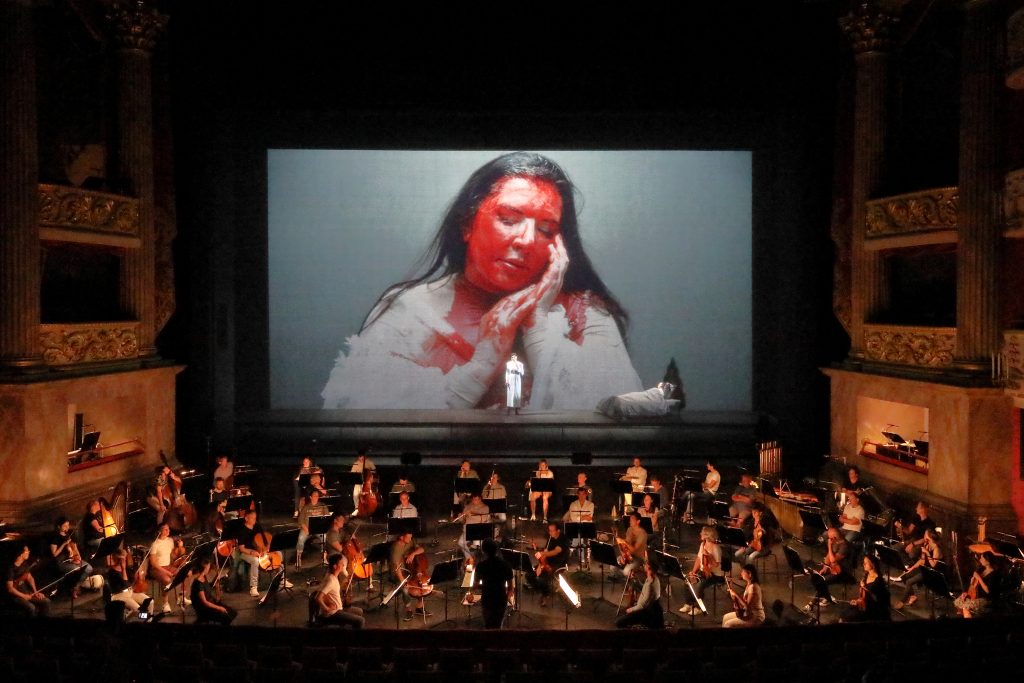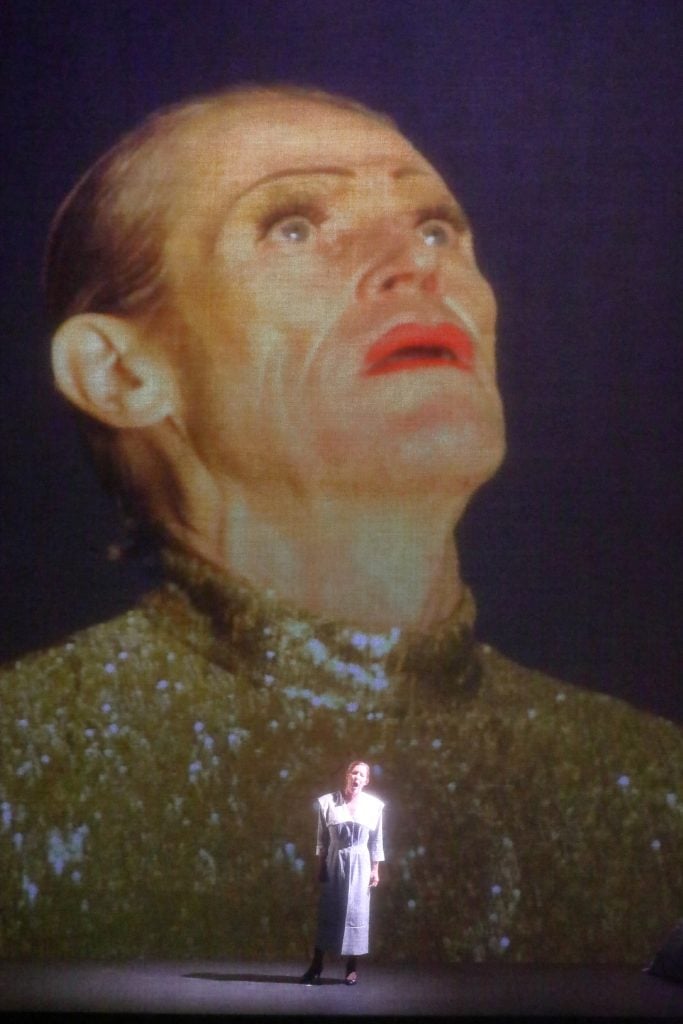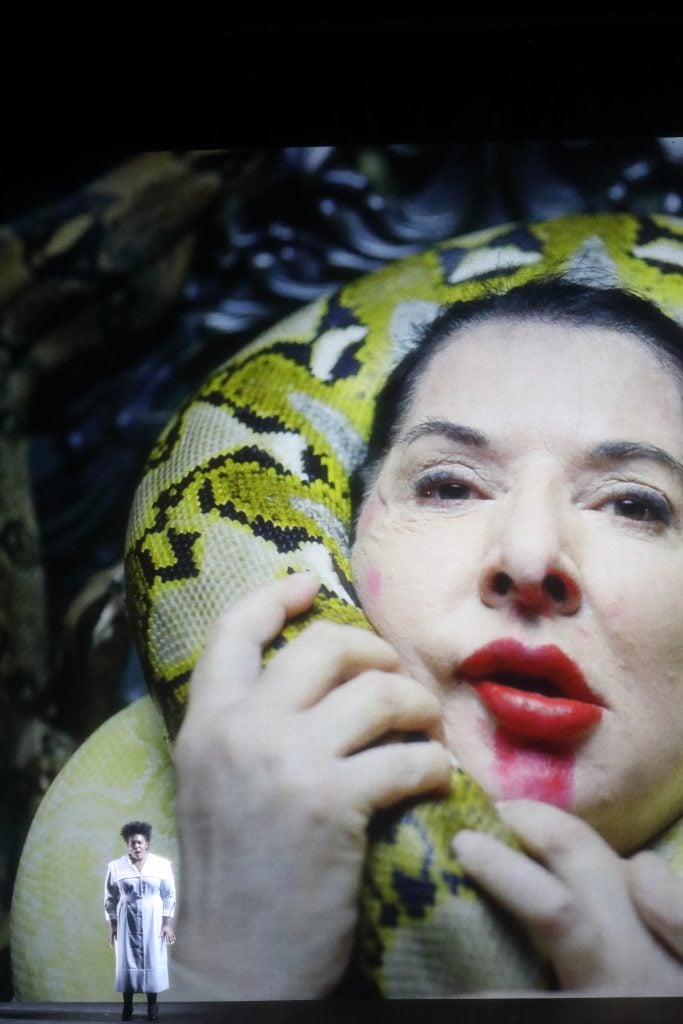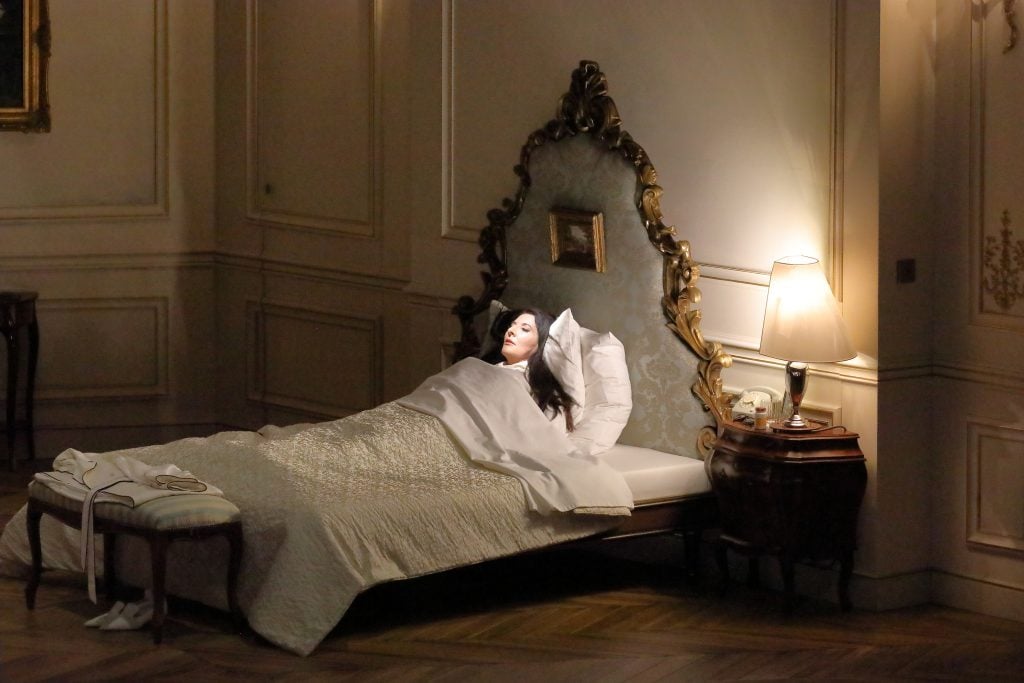Marina Abramović is certainly no stranger to being center stage.
The queen of performance art’s decades-long career has been marked by many boundary-dissolving moments, from encounters with Jay-Z to collaborations with Adidas and Microsoft. It is perhaps unsurprising then, that the shapeshifting artist has made a foray into opera.
Her first piece is opening tonight at the resplendent and historic Bavarian State Opera House in Munich, Germany. The Serbian artist is hosting the world premiere of her latest work, “7 Deaths of Maria Callas,” which has been delayed since April due to the coronavirus. The premiere will be available for streaming online on several platforms, including the opera houses website, beginning the following week, on September 5.
The initial plan for a packed, star-studded premiere at the 2,300-seat state opera house, is long-gone. The venue has now been converted to accommodate only 200 guests at a time. Even the first few rows have been removed to accommodate social distancing for the 40-piece orchestra, who normally sit cramped into a pit below.
But the show must go on, and the orchestra was warming up prior to the dress rehearsal last Saturday night as Abramović took to the stage to greet a small audience. She expressed regret at the challenges of working under such strict conditions. “We had so many difficulties and restrictions on everything,” she said, adding that after the premiere on September 2 she must quarantine in order to be able to perform for the next five nights.

7 Deaths of Maria Callas at the Bavarian State Opera. Photo: Wilfried Hösl. Courtesy the Bavarian State Opera.
“I can’t kiss you, I can’t hold you, I can’t share my enthusiasm with you, and that really breaks my heart,” she added.
A tragedy, perhaps, but one that is uniquely suited for this opera piece. Inspired by heartbreak in particular, the work is an ode to the American-born Greek soprano Maria Callas and her climactic solo performances—called arias—but also to the pain and suffering that accompanied the larger-than-life 20th-century divas off the stage. It follows the mythical story of Callas, whose dramatic life and love affair with the shipping magnate Aristotle Onassis often overshadowed her vocal prowess.
“If you look at the life of Maria Callas, her story is a lot like mine,” Abramović told Artnet News in a Zoom call ahead of the dress rehearsal. “It’s about dying from a broken heart, it’s about being killed by the one you love.”
She recounted the lonesome last few years of Callas’s life, which were spent as a recluse in her Paris flat after the death of Onassis in 1975, which left her bereft and inconsolable. Callas died of a heart attack in 1977 at just 53 years old. With a hint of remorse in her voice, Abramović alluded to her own relationship with artist Paolo Canevari that ended in heartbreak nearly a decade ago, while she spoke candidly about her life and work since the break up.
“I see a lot of myself in Callas,” Abramović said. “We’re both Sagittarius, we’re both intensely emotional, but fragile at the same time. I almost encountered a similar fate,” she added, saying that Callas died from a broken heart. “The difference [is that] my work saved me.”
Abramović says that the opera work is about female empowerment. “I wanted to show the strength and perseverance that a woman can have,” she said. “Not all heartbreak ends in tragedy. I believe in hope.”

7 Deaths of Maria Callas at the Bavarian State Opera. Photo: Wilfried Hösl. Courtesy the Bavarian State Opera.
The Seven Deaths
Abramović includes several key themes and elements from her own practice, including knives, snakes, fire, and even clouds emanating from a smoke machine, successfully interweaving her own signature with the life of the protagonist to the point that the two become almost indistinguishable.
Each of the seven main arias is accompanied by a short film projected on stage. In each segment, Abramović is killed by the Hollywood actor Willem Dafoe. The films were filmed last November in LA under the direction of Nabil Elderkin, whose made videos for musicians including Kanye West and Kendrick Lamar.
In the first half, Abramović spends much of it laying perfectly still, eyes closed, on a bed center-left of the stage. Cut to scores that reveal a wide emotional range referencing the various stages of grief, the combination of music and theater culminates into a sum that is much greater and more poignant than its individual parts. There are well-known pieces like “Addio del passato” from Giuseppe Verdi’s La Traviata and a climaxing “Casta Diva” from the 1831 Norma, alongside contemporary pieces made by Serbian composer Marko Nikodijevic.
The second half of the hour-and-thirty-minute piece is set in a reconstructed version of Callas’s Paris flat. There, Abramović gets up from the bed, slowly paces the room, unsure of the time of day, while the lyrics of the sopranos on-stage reveal Callas’s tortured inner dialog.
In the bedroom of Callas, Abramović’s slow choreography testifies to the challenges of performing even the most basic bodily functions while nursing a broken heart. Pacing the room in a state of bewildered melancholy, the passive intensity of each movement becomes excruciating and painful to watch.
As is often the case with strong, powerful female leads in the world of opera, the heroine is killed, but in this case, Abramović dies seven times. While some might say that the long-standing tradition of the dying diva is backgrounded by hedonistic misogyny, a subtext of emancipation soon emerges. Despite being killed in various ways by Dafoe, Abramović enters the stage standing and triumphant for her final death, clad in a shimmering gold gown, encountering her final fate with a sense of power.
“I wanted to take an old medium like the opera and deconstruct it, to make a new way of seeing it,” Abramović said.

7 Deaths of Maria Callas at the Bavarian State Opera. Photo: Wilfried Hösl. Courtesy the Bavarian State Opera.
Navigating Safety
To balance reduced audience numbers, social distancing, and a strong demand to see the piece, “7 Death of Maria Callas” will be broadcast live for free on September 5 on Staatsoper.TV, BR-Klassik Concert, and Arte Concert.
Yet for a woman like Abramović, who has made a career from placing herself in unsafe and often dangerous situations, the biggest challenge now is adjusting her performance art to confront a post-Covid-19 future. With so much skepticism and uncertainty, questions still remained up until the very last moment about whether the show would go on.
Yet when asked whether she thinks performance must now adapt to social distancing and what many argue is a “new normal,” the artist remained defiant.
“I don’t think performance needs to adjust to coronavirus,” she concluded, “I think coronavirus needs to adjust to performance.”
That true outcome may present a tragedy of a different sort. Perhaps the real heartbreak is yet to come.












